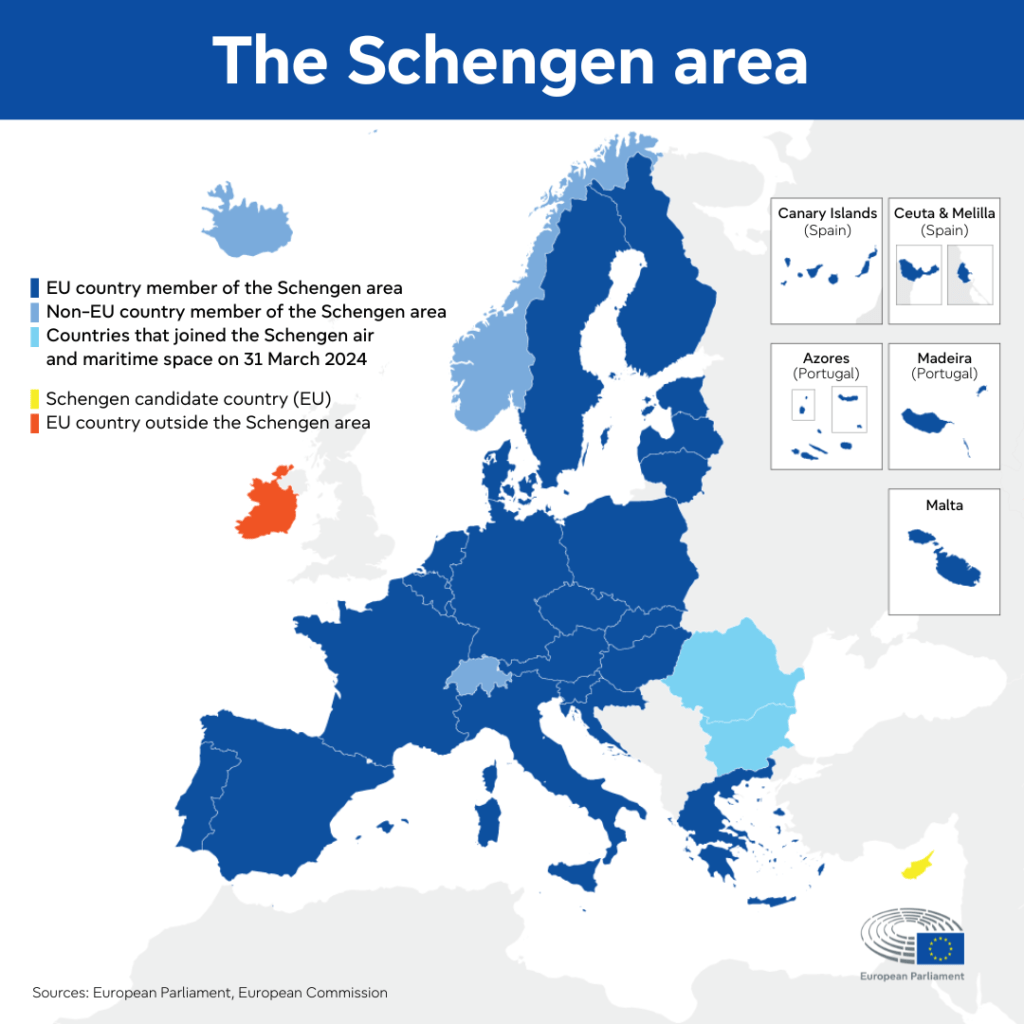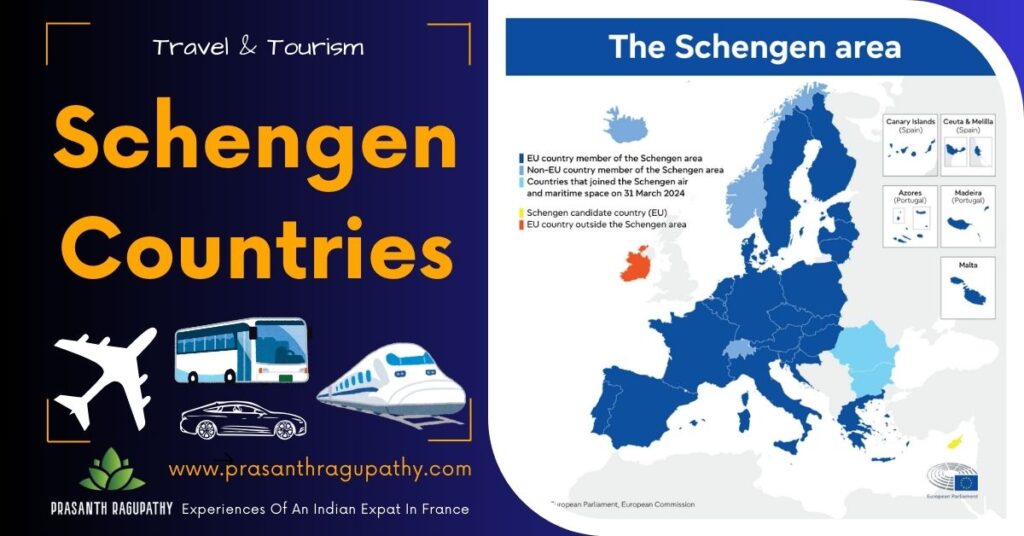Last updated on: September 11, 2024 | By: @rprasanth_kumar
The Schengen area covers over 4 million square kilometers with a population of almost 420 million people, and includes 29 countries:
- 25 of the 27 EU member states. Croatia joined in January 2023. Bulgaria and Romania from 31st March 2024.
- all members of the European Free Trade Association (Iceland, Liechtenstein, Norway and Switzerland).
Some generic rules
- People holding a Schengen visa or a resident permit from one of the Schengen countries can visit other Schengen countries too.
- They can travel and stay up to 90 days during a 180 days rolling period.
- Transits via Schengen countries: People falling in the above visa categories, do not require any transit visa when transiting via another country inside the Schengen area.
- For example: A person having a 1-year multiple entry Schengen tourist visa can spend 90 days in the area, leave the area for 90 days, visit again & stay for 90 days.
- The 90 days stay period includes all Schengen countries. For example: 30 days each in France, Spain & Italy.
- However, they can work only in the country where they have a work permit. A few exceptions are possible. Ex: EU Blue card.
- For International flights, immigration check always happens in the country of first entry or exit in the Schengen area.
- When travelling between 2 Schengen countries, your visa or resident permit must be accompanied by your Passport. This is applicable irrespective of the mode of transport. For more details, Can I travel in Europe without carrying my Passport?.
- As a general rule you may cross any Schengen border with visa issued by any Schengen country. For example: Entering Schengen area via France using a tourist visa issued by Italy or Spain. However, the short-stay visa does not automatically entitle you to enter the Schengen area. Please see the FAQs in the end.
List of Schengen Countries
| Country | Official Website |
| Austria 🇦🇹 | |
| Belgium 🇧🇪 | |
| Bulgaria 🇧🇬 | tourism.government.bg |
| Croatia 🇭🇷 | croatia.hr |
| Czech Republic 🇨🇿 | visitczechia.com |
| Denmark 🇩🇰 | denmark.dk/visiting-denmark |
| Estonia 🇪🇪 | visitestonia.com |
| Finland 🇫🇮 | visitfinland.com |
| France 🇫🇷 | france.fr |
| Germany 🇩🇪 | deutschland.de/en/travel-in-germany |
| Greece 🇬🇷 | visitgreece.gr |
| Hungary 🇭🇺 | abouthungary.hu |
| Iceland 🇮🇸 | visiticeland.com |
| Italy 🇮🇹 | italia.it |
| Latvia 🇱🇻 | latvia.travel |
| Liechtenstein 🇱🇮 | tourismus.li |
| Lithuania 🇱🇹 | lithuania.travel |
| Luxembourg 🇱🇺 | visitluxembourg.com |
| Malta 🇲🇹 | visitmalta.com |
| Netherlands 🇳🇱 | holland.com/global/tourism |
| Norway 🇳🇴 | visitnorway.com |
| Poland 🇵🇱 | poland.travel |
| Portugal 🇵🇹 | visitportugal.com |
| Romania 🇷🇴 | romaniatourism.com |
| Slovakia 🇸🇰 | slovakia.travel |
| Slovenia 🇸🇮 | slovenia.info |
| Spain 🇪🇸 | spain.info |
| Sweden 🇸🇪 | visitsweden.com |
| Switzerland 🇨🇭 | myswitzerland.com |

Frequently Asked Questions (FAQs)
Q1. Can I enter the Schengen area in country A, while the visa was
issued by Schengen country B?
- As a general rule you may cross any Schengen border with visa issued by any Schengen country. For example: Entering Schengen area via France using a tourist visa issued by Italy.
- However, the short-stay visa does not automatically entitle you to enter the Schengen area. At border (or during other controls) you may have to show the visa but also provide additional documentation, for example information on that you have sufficient means to cover the stay and the return trip.
- It is therefore very important that you carry with you copies of the documents which you presented when applying for the visa (e.g. letters of invitation, travel confirmations, travel itinerary, other documents stating the purpose of your stay).
- Personally, I would recommended entering via the country which issued the tourist visa and avoid any unnecessary complications.
Q2: My visa has been issued by, for example, the French Embassy. Can I use this visa for travelling to other Schengen States?
- Yes. According to the Schengen rules, the Schengen visa is generally valid for all the countries in the Schengen area.
- Please note, however, that you always have to apply at the embassy/consulate of the country which is your primary destination.
- The territorial validity of your visa is indicated on the visa sticker under the heading “Valid For”.
Q3: How long before the start of the intended visit should I apply for a visa?
- Applications can be submitted no more than three months before the start of the intended trip and and at least 15 calendar days before the travel date.
- However it is also recommended that you submit the visa application taking into account national holidays of the Schengen State of destination and in the country where you apply for the visa.
- Holders of a multiple-entry visa (valid for a period of at least six months) may submit the application for a new visa before the expiry of that visa.
Q4: How long can I stay in the Schengen area on the basis of my visa?
- The Schengen visa is a short stay visa and takes the form of a sticker, usually pasted on the passport.
- The definition of “short stay” is a stay of “90 days in any 180 days period”. This means that the total duration of stay is of maximum 90 days, in any
period of 180 days. The precise length of validity of your visa is indicated on the visa sticker under the heading “Duration of visit”. - With a single-entry visa you can enter the Schengen area only once. This is indicated on the visa sticker under the heading “Number of entries” by “1”.
- A two-entry or a multiple-entry visa allows for two or several entries during the validity of the visa. This is indicated on the visa sticker by “02” or “MULT” under the heading “Number of entries”.
Support This Blog!
If you’ve found my articles helpful, interesting or saving your time and you want to say thanks, a cup of coffee is very much appreciated!. It helps in running this website free for the readers.
Sources & References
- Schengen Area – European Commission home-affairs.ec.europa.eu
- The Schengen area explained consilium.europa.eu
- Schengen: enlargement of Europe’s border-free area europarl.europa.eu
- MEPs give green light to a reformed Schengen Borders Code europarl.europa.eu
- Visa application guidelines france-visas.gouv.fr
- VFS Global vfsglobal.com/en
- A Step-by-Step Guide to apply for a Schengen Visa india.diplo.de/in-en


